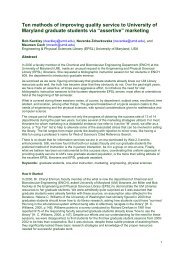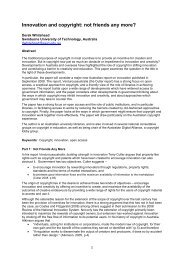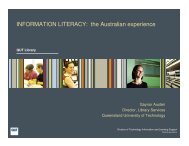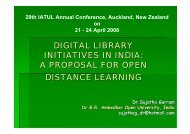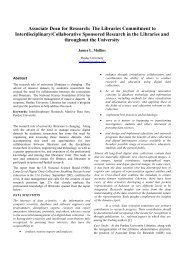Thinking styles and their role in teaching and learning Abstract - IATUL
Thinking styles and their role in teaching and learning Abstract - IATUL
Thinking styles and their role in teaching and learning Abstract - IATUL
You also want an ePaper? Increase the reach of your titles
YUMPU automatically turns print PDFs into web optimized ePapers that Google loves.
A strong emphasis, backed by <strong>in</strong>dustry, is on the improvement of the softer, “non-technical” skills<br />
of eng<strong>in</strong>eer<strong>in</strong>g students. American, Australian, British <strong>and</strong> South African studies reveal that<br />
employers believe that entry level employees are deficient <strong>in</strong> the broader non-technical skills <strong>and</strong><br />
that educational <strong>in</strong>stitutions need to place more emphasis on teach<strong>in</strong>g these skills (Busse 1999).<br />
Eng<strong>in</strong>eer<strong>in</strong>g educational programmes have traditionally done exceptionally well <strong>in</strong> develop<strong>in</strong>g<br />
analytical <strong>and</strong> technical competencies of students (Lumsda<strong>in</strong>e & Lumsda<strong>in</strong>e 1995) but little has<br />
been done for the development of social th<strong>in</strong>k<strong>in</strong>g <strong>and</strong> communication skills.<br />
This trend to create a balance between technical <strong>and</strong> non-technical aspects <strong>in</strong> the tra<strong>in</strong><strong>in</strong>g <strong>and</strong><br />
education of eng<strong>in</strong>eers is evident <strong>in</strong> eng<strong>in</strong>eer<strong>in</strong>g education <strong>and</strong> curriculum designs worldwide.<br />
In order to facilitate the development of non-technical skills of first year students a teach<strong>in</strong>g <strong>and</strong><br />
learn<strong>in</strong>g facilitation strategy based on an awareness of Herrmann’s four quadrant whole bra<strong>in</strong><br />
pr<strong>in</strong>ciples was <strong>in</strong>troduced <strong>in</strong> the Department of Civil Eng<strong>in</strong>eer<strong>in</strong>g <strong>in</strong> 1999. The study <strong>in</strong>cluded 50<br />
first year civil eng<strong>in</strong>eer<strong>in</strong>g students. The HBDI was used to give students <strong>in</strong>sight <strong>in</strong>to <strong>their</strong> own<br />
th<strong>in</strong>k<strong>in</strong>g preferences, to determ<strong>in</strong>e the homogeneity/diversity of the group of students <strong>and</strong> to give<br />
educators <strong>in</strong>sight <strong>in</strong>to the distribution of <strong>their</strong> student’s preferred modes of th<strong>in</strong>k<strong>in</strong>g.<br />
As <strong>in</strong> the previous research f<strong>in</strong>d<strong>in</strong>gs, the profiles of the students, displayed an array of<br />
preferences distributed over all four quadrants of the Herrmann’s Whole Bra<strong>in</strong> Model (Horak,<br />
Steyn & De Boer 2001:202). On average, the dom<strong>in</strong>ant th<strong>in</strong>k<strong>in</strong>g preferences of the group<br />
revealed a dist<strong>in</strong>ct tilt towards the preference for the th<strong>in</strong>k<strong>in</strong>g modes of the left hemisphere. The<br />
composite profile of the th<strong>in</strong>k<strong>in</strong>g modes reveal a strong preference for the upper left A-quadrant,<br />
followed by a preference for the lower left B-quadrant, followed by a lesser preference for the<br />
th<strong>in</strong>k<strong>in</strong>g modes of the upper right D-quadrant <strong>and</strong> a low preference for the lower right C-quadrant<br />
mode. Individual preferences however revealed strong preferences <strong>in</strong> all four quadrants. These<br />
f<strong>in</strong>d<strong>in</strong>gs are <strong>in</strong> accordance with those of Lumsda<strong>in</strong>e & Lumsda<strong>in</strong>e (1995) who conducted a<br />
research project on a large scale with students enrolled <strong>in</strong> a Faculty of Eng<strong>in</strong>eer<strong>in</strong>g <strong>in</strong> the United<br />
States of America.<br />
For the eng<strong>in</strong>eer<strong>in</strong>g students, as well as the educators, it became apparent that traditional<br />
approaches to educational design <strong>and</strong> delivery could fall short of desired results when deal<strong>in</strong>g<br />
with a composite group of learners with th<strong>in</strong>k<strong>in</strong>g style preferences distributed across all four<br />
quadrants. After exposure <strong>and</strong> application of the HBDI model it was evident that the students<br />
showed a significant <strong>in</strong>crease <strong>in</strong> socialization <strong>and</strong> group acceptance of the value of diversity were<br />
obvious <strong>in</strong> the projects <strong>and</strong> group work they participated <strong>in</strong>.<br />
• Second year students enrolled for a degree <strong>in</strong> Library <strong>and</strong> Information Science<br />
At the beg<strong>in</strong>n<strong>in</strong>g of 2000 another research project was done on second year students enrolled for<br />
a degree <strong>in</strong> Library <strong>and</strong> Information Science. The aim was also to determ<strong>in</strong>e the th<strong>in</strong>k<strong>in</strong>g<br />
preferences of both students <strong>and</strong> the educators responsible <strong>and</strong> to adapt the curriculum <strong>and</strong><br />
teach<strong>in</strong>g approach if necessary. The research f<strong>in</strong>d<strong>in</strong>gs revealed once aga<strong>in</strong> that both the<br />
educators <strong>and</strong> students have diverse th<strong>in</strong>k<strong>in</strong>g <strong>styles</strong> (De Boer, Coetzee & Coetzee 2001:119).<br />
The composite profile of the group revealed a strong preference for the left lower B-quadrant, <strong>and</strong><br />
right lower C-quadrant.<br />
What was significant <strong>in</strong> the results was the fact that the students’ profiles were not <strong>in</strong> alignment of<br />
what is expected <strong>in</strong> the profession of catalogu<strong>in</strong>g <strong>and</strong> classification. In many fields of the<br />
<strong>in</strong>formation profession, <strong>their</strong> preferred th<strong>in</strong>k<strong>in</strong>g <strong>styles</strong> will be an asset, but what cataloguers <strong>and</strong><br />
those who do subject catalogu<strong>in</strong>g <strong>and</strong> classification need are essentially analytical, technical<br />
proficiency <strong>and</strong> problem solv<strong>in</strong>g skills associated with A-quadrant th<strong>in</strong>k<strong>in</strong>g preferences - skills that<br />
the students’ profiles <strong>in</strong>dicate as be<strong>in</strong>g <strong>their</strong> least preferred modes of th<strong>in</strong>k<strong>in</strong>g.



